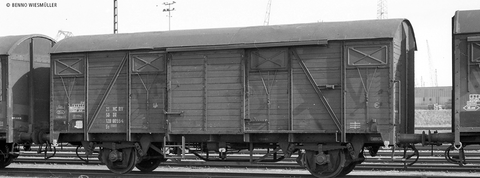
Brawa 50108 Covered Freight Car Gs [1200] MC RIV DR
The International Union of Railways (Union internationale des chemins de fer, UIC) founded its own research and development institute (ORE) in 1949, thus laying the foundation for internationally standardised construction principles for goods wagons. The European railway administrations soon developed their own vehicles on the basis of the ORE’s designs and principles for a two-axle standard goods wagon. In accordance with the fundamental idea put forward by the UIC, these were used within the territories of the member administrations to transport goods and freight. The German Federal Railway (Deutsche Bundesbahn) took the first steps via an initial procurement of around 3,500 wagons (as per the preliminary designs) and, with the Gmm(e)hs 56, successfully put the first 2,662 genuine UIC standard wagons into service as early as 1957. Externally, the standardised design was indicated by the inscription RIV St UIC. Other railway administrations, including the SNCF, FS, ÖBB, NS, DSB, MAV, P.K.P., CFL, SBB, acted in a similar way and produced their own versions of the UIC standard wagons. The wagons are all very similar due to this fact, however they also include some country-specific design differences. Since DB had a very high demand for new wagons and there was also a modernisation backlog for older wagon classes, they did not solely rely on brand new UIC St wagons. The wagon types Gmms 44, Gmm(eh)s 60, Gmms 40 and 216 were gradually created via several conversion programmes in which individual parts from older wagons were reused. With over 100,000 units built, these wagon types became synonymous with goods traffic in Europe and were used in almost every goods train from the 1960s to the 1990s.
50108
